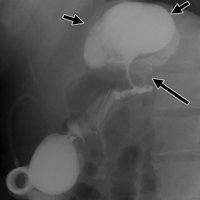Lap-Band revision surgery can fix your problems with the band, including not enough weight loss or complications that require band removal.
Your 4 revision options include:
- Rebanding
- Convert to gastric sleeve
- Convert to gastric bypass
- Convert to duodenal switch
Band removal and conversion to the new procedure usually happens during the same operation.
If you have insurance that covers bariatric surgery, your revision procedure will be covered. Otherwise, it will probably cost between $20,000 and $29,000 before discounts and tax savings are applied.
Read the sections below for everything you need to know about your Lap-Band revision options.
TABLE OF CONTENTS
Click on any of the topics below to jump directly to that section
- When to Consider
- One- Vs Two-Stage Revision
- 4 Revision Procedures
- Insurance
- Cost Without Insurance
- Patient Community & Expert Advice
- Find a Weight Loss Surgeon

SECTION SUMMARY:
- You should consider a revision if you haven't lost enough weight; or
- You're suffering from a complication that requires removal of your lap band
Lap band revision generally occurs for two reasons, 1) lack of weight loss or 2) complications with the lap band.
Historically, 30+% of gastric band patients eventually required band removal (1). Recent studies have a better outlook, with the 5-year removal rate now under 9% for patients who maintain continued interaction with their surgical team and follow established guidelines closely (2).
The tables below show a collection of studies outlining complication risks and weight loss failure rates for the lap band:
Unsuccessful weight loss
“Unsuccessful” means different things to different surgeons, but in general a procedure is considered to be a failure if you lose 25% to 30% or less of your excess weight (in other words, if you’re 100 pounds overweight that would mean you lost 25 to 30 pounds or less). Complete success generally means 50% or more of excess weight lost.
The following 3 studies directly reported on the percentage of failures, which were as low as 14% and as high as 68% of patients…
Unsuccessful weight loss
| Studies | # of lap band patients in study | % of patients with unsuccessful weight loss after a specified amount of time | Year of Study |
|---|---|---|---|
| Study A | 201 | After 14 years – 68% | 2014 |
| Study B | 32 | After 3.6 years – 62.5% | 2014 |
| Study C | 200 | 28.8% | 2014 |
| Study D | 317 | After 18months -13.2% 3 Years – 23.8% 5 Years – 31.5% 7 Years – 36.9% | 2006 |
| Study E | 190 | After 3 Years – 19% | 2004 |
Complications that require removal of the band
Anywhere from 5% to 10% of patients have their band completely removed due to complications as the following three studies demonstrated…
Complications that require removal of the band
| Studies | # of lap band surgery patients | % of patients with band removal due to a complication | Year of Study |
|---|---|---|---|
| Study A | 172 | 9.3% | 2008 |
| Study B | 591 | 8.6% | 2008 |
| Study C | 1,180 | 5.6% | 2004 |
Problems that require lap band removal usually include one of the following complications, however, good bariatric doctors can often repair the problems without removing the band (3):
- Band problems:
- Band erosion This occurs when the band grows into the stomach. The only treatment is permanent removal of the band. Symptoms may include variation in food consumption and/or changes in the amount the band requires to be
filled.
See our Lap Band Erosion page for more information. - Band infection – (1.5% – 5.3% of patients) – if this occurs, it is usually healed with antibiotics, but removal of the band may be necessary.
- Band intolerance symptoms include excessive vomiting or a continuous feeling of discomfort. If these symptoms do not subside, removal of the band is the only option.
- Band slippage (2% – 18% of patients) – occurs when the lower part of the stomach “slips” through the band, creating a bigger pouch above the band. This is also referred to as a “lap band prolapse.” Either removing fluid (from
the lap band) or surgical repositioning it is required to repair it, although band removal may be necessary.
Symptoms include vomiting and reflux, and it’s diagnosed by drinking a dye and checking for leaks via X-Ray. The band placement technique used by the surgeon also makes a difference; between the perigastric technique (PGT) and the pars flaccida technique (PFT), the pars flaccida technique appears to have a much lower rate of slippage (up to 16% less often).
See this study for additional images of band slippage and more information about proper diagnosis. Short arrows show pouch dilatation;
Short arrows show pouch dilatation;
Large arrows show small amounts of
contrast material passing through
gastric band(4)
- Band erosion This occurs when the band grows into the stomach. The only treatment is permanent removal of the band. Symptoms may include variation in food consumption and/or changes in the amount the band requires to be
filled.
- Difficulty swallowing (also called “dysphagia”) is caused by eating too quickly, too much or not chewing food enough. While it can usually be avoided by addressing these issues, some patients’ bodies simply can’t get over this problem, in which case band removal is required.
- Esophageal Dysmotility and/or Dilatation – as a result of the patient’s gastric band, the esophagus cannot move food from the mouth to the stomach as well as it should. Symptoms may include difficulty swallowing, regurgitation of food and/or pain.
- Gastro-esophageal reflux disease (GERD) is a highly variable chronic condition that is characterized by periodic episodes of gastro-esophageal reflux usually accompanied by heartburn and that may result in histopathologic changes
in the esophagus. It also often leads to esophagitis. GERD increases the risk of some bariatric surgery complications such as sepsis, but the condition is also improved for many patients following bariatric surgery.
Several at-home treatments are effective, including avoiding certain foods and drinks (alcohol, citrus juice, tomato-based food and chocolate), waiting 3 hours before lying down after a meal, eating smaller meals and elevating your head 8 inches when you lay down. If these don’t work, your doctor may recommend/prescribe antacids to be taken after meals and before going to bed, H2 blockers or even Proton Pump Inhibitors (PPI). If the condition becomes too severe, it may require removal of the band. - Port infection (1.5% – 5.3% of patients) – can occur in your abdomen at the port site. It is usually healed with antibiotics, but removal of the band or port may be necessary.
- Pouch dilation (4.4% of patients) – refers to the enlarging of the pouch created after lap band surgery. It can often be fixed by removing fluid from the band but sometimes requires reoperation.
SECTION SUMMARY:
- One-stage removal means the band is removed and the new weight loss procedure is done at the same time
- A one-stage revision is most common type
Any lap band revision procedure may be performed as a single-stage (band removed and new weight loss surgery technique performed during same procedure) or two-stage procedure (band removed during first procedure, sleeve performed during later procedure performed after healing).
Which method is best for you will depend on your situation, but most surgeons recommend a single-stage procedure.
However, if your band is being removed due to certain complications, it may be best to let your body heal before converting to another surgery. In this less common case, two procedures may be more appropriate.

SECTION SUMMARY:
- You could undergo a "rebanding"
- You could convert from Lap-Band to a Gastric Sleeve
- You could convert to a Gastric Bypass
- You could convert to a Duodenal Switch (DS)
Following are your 4 lap band revision surgery options along with corresponding research results.
Note that studies evaluating lap band conversion to some procedures are extremely limited; we will continue to stay on top of new research and post updates as they are published.
Rebanding
Removing the old band and replacing it with a new one. Among the limited available research, it appears that results are similar for lap band surgery as a primary procedure and secondary (rebanding) procedure. If your initial gastric band was not successful, most surgeons would not recommend another band.
| Study Links | # of Patients | Complication Rate | Mortality Rate | Weight Loss | Year of Study |
|---|---|---|---|---|---|
| Study A | 81 | n/a | n/a | Weight loss “failure”: 54% | 2013 |
Lap Band Revision Surgery to Gastric Sleeve
Excess weight lost following revision to gastric sleeve surgery may be as high as 60% compared your pre-band removal weight. Risk of complications were most often reported as being under 16%, and there were no deaths as the result of surgery reported in any of the studies we reviewed.
| Study Links | # of Patients | Complication Rate | Mortality Rate | Weight Loss | Year of Study |
|---|---|---|---|---|---|
| Study A | Single-Stage: 32 | 15% | 0% | At 12 month: 9 point drop in BMI | 2014 |
| Study B | Single-Stage: 2 Two-Stage: 6 | 33% | 0% | At 19 Months: 28% of excess weight lost | 2014 |
| Study C | Two-Stage: 34 | 2.9% | n/a | At 1 year: 52% At 2 years: 60% | 2014 |
| Study D | 25 | n/a | n/a | At 2 years: 28% for revision due to lack of weight loss | 2014 |
| Study E | Single-stage: 40 | 7.5% | n/a | At 1 year (avg): 57% | 2014 |
| Study F | Single Stage: 56 | 5.5% | 0% | At 2 years: 14.3 point absolute reduction in BMI from pre-banding | 2013 |
| Study G (review of other studies) | 286 | Short-term: 15.7% Long-term: 2.5% | n/a | n/a | 2013 |
| Study H (review of other studies) | 106 | n/a | n/a | At 4 years: 35% | 2012 |
Lap Band Revision Surgery to Roux-en-Y Gastric Bypass
Revision to gastric bypass was recommended more often than any other procedure among the available research. Reported weight loss since band removal was as high as 70% of excess weight, and complication rates ranged from 9% to 17%.
| Study Links | # of Patients | Complication Rate | Mortality Rate | Weight Loss | Year of Study |
|---|---|---|---|---|---|
| Study A | Single-Stage: 200 | n/a | 0% | n/a | 2014 |
| Study B | Single-Stage: 177 | 8.5% | 30 day: 0.5% | n/a | 2014 |
| Study C | Two-Stage: 74 | 16.2% | n/a | At 1 year: 59% At 2 years: 70% | 2014 |
| Study D | 22 | n/a | n/a | At 2 years: 55% for revision due to lack of weight loss | 2014 |
| Study E | Single-stage: 195 | 9% | 0% | At 5 years: 53% | 2014 |
| Study F | Single-Stage: 56 Two-Stage: 52 | 10.2% | n/a | After 3.5 years (avg; max 10 yrs): BMI decreased by an additional 9 points | 2013 |
| Study G (review of other studies) | 588 | Short-term: 8.5% Long-term: 8.9% | n/a | n/a | 2013 |
| Study H (review of other studies) | 514 | n/a | n/a | At 4 years: 48% | 2012 |
| Study I | 94 | 7.50% | 0% | N/A | 2016 |
Lap Band Revision Surgery to Duodenal Switch (DS)
DS seems to have more weight loss than gastric bypass along with a higher risk of complications.
| Study Links | # of Patients | Complication Rate | Mortality Rate | Weight Loss | Year of Study |
|---|---|---|---|---|---|
| Study A (review of other studies) | 71 | n/a | n/a | At 2 years: 78% | 2012 |
| Study B | 21 | 62% (however, study specifically states that “complications were, in part, related to the learning curve” of performing the procedure) | 0% | At 18 months: 73% | 2007 |
Click here to contact a surgeon to discuss which procedure is best for your situation.
SECTION SUMMARY:
- Lap-Band revision surgery is covered if your policy includes bariatric surgery (see details below)
If you have insurance that covers bariatric surgery, your plan will likely pay for both the removal of your band and the revision to another procedure. Of course, any applicable deductibles, copays and coinsurance will apply.
Use the tool below to find out if your plan includes weight loss surgery.
Click Here to Check Your Insurance
SECTION SUMMARY:
- Total Cost of a Lap-Band Revision is $20,000 – $29,000
- If you take out a loan to finance your revision, the average monthly loan payment is ~$550
- There are usually discounts & tax savings available (see details below)
If performed as a single-stage procedure, total fees for the surgeon’s portion of the work are likely to be about 30% higher than they would be if your new surgery was performed as a primary procedure (instead of a revision).
If performed as a two-stage procedure, there would be two separate hospital and anesthesia charges (no discount) and two separate sets of professional fees (the surgeon would likely discount their fees).
Based on our most recent Annual Bariatric Surgeon Cost Survey, the total average costs of a single-stage Lap-Band removal plus conversion procedure in the U.S. are as follows (assumes surgeon/professional fees are 20% of total cost):
- Lap Band Conversion to Gastric Sleeve: About $20,100 (U.S. Average)
- Lap Band Conversion to Gastric Bypass: About $25,500 (U.S. Average)
- Lap Band Conversion to Duodenal Switch: About $28,600 (U.S. Average)
Hospital & Anesthesia Cost Details
While many bariatric surgeons work closely with hospitals to develop a packaged fee, hospital charges are ultimately independent of the surgeon’s charges.
The hospital and anesthesia portions of the cost will vary from hospital to hospital. For example:
- Some hospitals offer a set fee regardless of procedure performed
- Some may add an extra amount for the more involved revision procedure (as compared to a primary bariatric procedure)
- Some may charge on a “fee for service” basis (pay depending on operating time and materials used)
While many bariatric surgeons work closely with hospitals to develop a packaged fee, hospital charges are ultimately independent of the surgeon’s charges.
Region-Specific Lap-Band Revision Surgery Cost Estimates
For region-specific estimates for each separate lap band conversion procedure, use the interactive map below to find the average cost of the chosen conversion procedure in your area (gastric sleeve, gastric bypass or duodenal switch) and use the following equation:
Estimated Average Lap Band Revision Cost for Your Area
=
(Average Cost of New Procedure in Your Area (use tool below) X 0.2 X 1.3)
+
(Average Cost of New Procedure in Your Area (use tool below) X 0.8)
Discounts: 6 Discounts to Ask Your Surgeon About
Talk with your surgeon about whether any of these discounts are available:
- Self-Pay Discounts. Most surgeons offer self-pay discounts or payment plans. Just ask!
- Other Discounts. Some offer discounts if you pay the total amount in advance.
- Same Surgeon, Different Hospitals. Some surgeons operate at more than one hospital. Hospital costs make up the biggest part of the bill, so find out if your surgeon has a choice.
- Pre-Op Costs. Some surgeons include pre-op costs in their quoted fees. Pre-op costs include things like testing and office visits.
- Complications. Should they arise, may increase total costs. Ask your surgeon who will pay if a complication arises during surgery. Some surgeons will include the cost of any complications in their quote while others will charge extra.
- Health Insurance That Does Not Include Bariatric Surgery. You may still get insurance to pay for some costs that could be applied to covered treatments. For example, lab work is needed for many reasons outside of bariatric surgery. Your surgeon can help you find those advantages in your plan.
Financing: 7 Ways to Make Surgery More Affordable
Lap-Band revision surgery financing is available almost everywhere. It helps pay for:
- The entire cost of surgery
- The part that insurance doesn’t cover, like deductibles, copays, or coinsurance
Financing options to make gastric sleeve surgery more affordable include:
- Payment Plan Through a Qualified Surgeon
- Brokers, Direct Lenders, and Credit Cards (Unsecured Medical Loans)
- Friends & Family
- Secured Medical Loans
- Retirement Plan Loans
- Permanent Life Insurance Loans
- Medical travel – having surgery in a location that is less expensive than where you live
Click here for more information about each option.
Tax Savings: Tax Deductions & Special Tax-Favored Accounts
Click your country below to find out if tax savings are available:
United States: Might Be Deductible, Special Tax-Favored Accounts Available
Lap-Band surgery is tax deductible, which can have a big impact on the total cost of surgery.
You can deduct medical expenses if the costs are more than 10% of your adjusted gross income.
To receive the deductions, you’ll need to complete Schedule A of the IRS Form 1040. You’ll also need to save your medical bills and payment statements as proof.
Money in special savings accounts (or even your IRA) may also be a way to pay for part of surgery tax-free:
- Health Savings Account (HSA) – You can open an HSA alongside a “qualified high deductible” health plan. Tax-free HSA money can be used to pay for qualified medical expenses. No other account receives better tax treatment. You can even transfer IRA money into an HSA. See the IRS’s Site for more info.
- Archer Medical Savings Account (Archer MSA) – Archer MSAs are like HSAs for the self-employed or small businesses. Click here for details.
- Health Reimbursement Account (HRA) – HRAs are only offered by employers who set them up and contribute money to them. If your company offers one, make sure your plan allows the use of HRA funds to pay for “all qualified medical expenses.” Click here for more info.
- Flexible Spending Account (FSA) – Both employers and employees can contribute to an FSA, also known by its IRS code, “Section 125”. Money from them can be taken out tax-free if it is used for qualified medical expenses. Click here to get the summary from the IRS.
Canada: Is Deductible
Canada is generous compared to other countries when it comes to medical tax deductions. If you have a prescription, receipt, or other documentation, you can write off your Lap-Band surgery expenses.
If surgery is covered by your insurance, you can also deduct your:
- Out-of-pocket expenses
- Monthly insurance premium
If your income is below a certain amount, you may qualify for a tax credit called the refundable medical expense supplement.
Australia: Might Be Deductible
In Australia, you can write off your Lap-Band surgery expenses if the costs are over the Australian Taxation Office (ATO) threshold.
According to the ATO:
“To claim the net medical expenses tax offset in your tax return, you will need to know the total medical expenses you incurred for yourself and your dependants. You then deduct any refunds from Medicare, your health fund or any other reimbursements that relate to those expenses received during the financial year.”
Click here for updated Medicare Benefit Tax Statement information from the Department of Human Services.
SECTION SUMMARY:
- Ask the expert
- Patient experiences
We would love to hear your experiences with Lap-band revisions. Your insights are invaluable to making sure other people have the tools to meet their goals.
We would also be happy to answer any questions you may have about Lap-band revisions.
Please use the form below to share your experience or ask a question.
Questions From Other Visitors*
Click below to see contributions from other visitors to this page.
I have been banded for 4 years, successfully losing 30 kgs (66 lbs) and putting my Type 2 diabetes into remission. Approx 12 month ago, my band slipped and was…
Lap Band Revision to Gastric Sleeve*I was banded 4 years ago which has been successful. I've lost 30kgs and diabetes is in remission. I had a band slippage approx 12 months ago band was put…
Lap Band Revision Surgery with Scar Tissue Problem*I have had my lap band for 4 years. It was successful until a year ago when my band slipped. My surgeon was able to put it back into a…
Time for Revision Surgery from Lap Band to Gastric Sleeve?*I have had an Allergan Lap-Band in for 6 years, and for over 3 years I have experienced heart burn. I am on prescription meds Protonix at first now Dexilant,…
SECTION SUMMARY:
- You can ask a local bariatric practice for a free insurance check or cost quote for your revision
- You should schedule a phone or in-person consultation (both often free), if you are interested in learning more about lap-band revision surgery
Search the gastric bypass surgeon directory below to find a weight loss surgeon by country and region:



